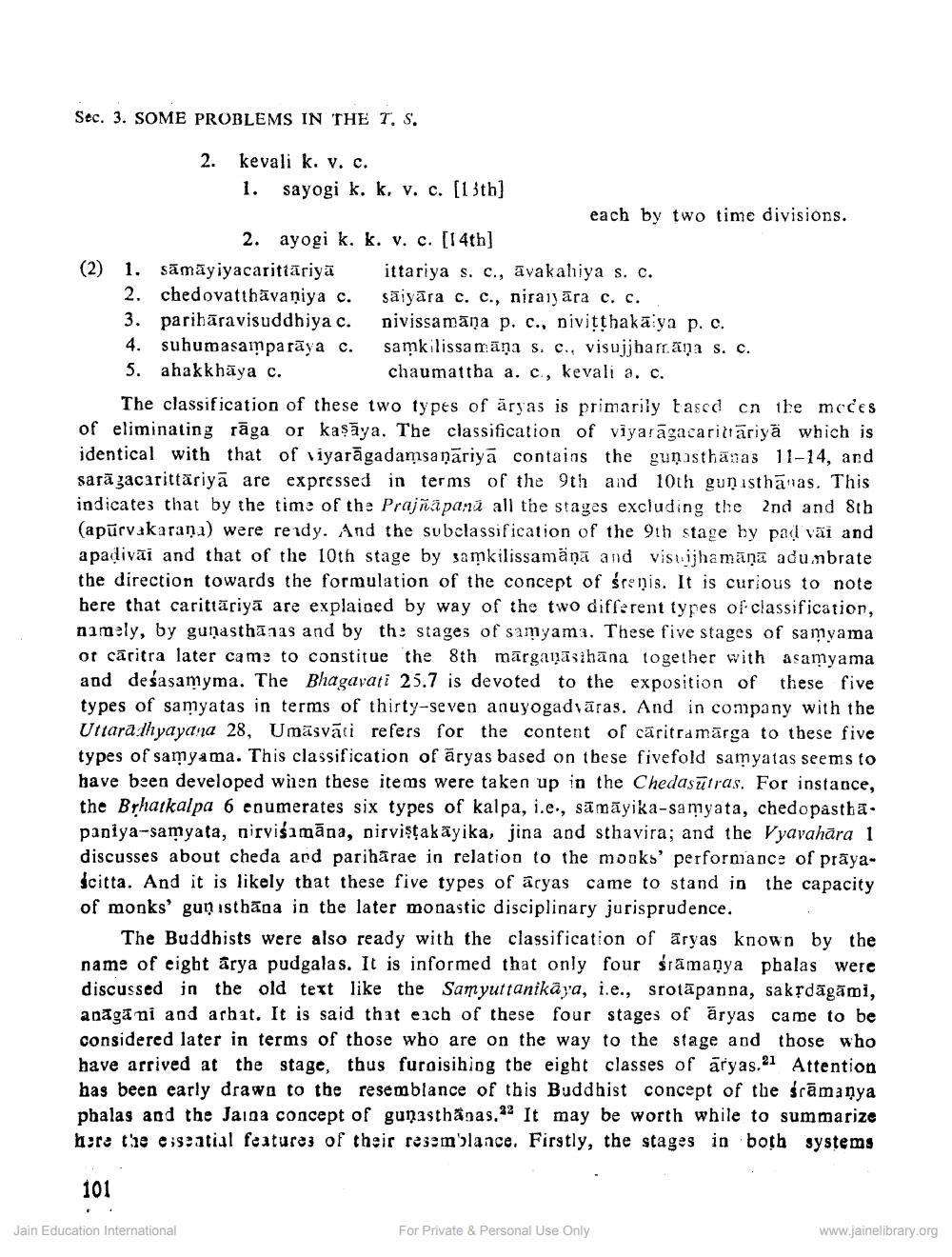________________
Sec. 3. SOME PROBLEMS IN THE T. S.
2. kevali k. v. c. 1. sayogi k. k, v. c. [13th]
each by two time divisions. 2. ayogi k. k. v. c. [14th] (2) 1. sāmāyiyacarittäriyā ittariya s. c., āvakahiya s. c.
2. chedovatthāvaniya c. säiyāra c. c., niraiyāra c. c. 3. parihāravisuddhiya c. nivissamāņa p. c., Divitthakāya p. c. 4. suhumasamparāya c. samkilissa māņa s. c., visujjhartana s. c. 5. ahakkhāya c.
chaumattba a. C., kevali a. c. The classification of these two types of äryas is primarily tased on the modes of eliminating rāga or kaşāya. The classification of viyarāgacarittäriyä which is identical with that of viyarāgadamsaņāriyā contains the gunasthanas 11-14, and sarāzacarittäriyā are expressed in terms of the 9th and 10th guņisthāvas. This indicates that by the time of the Prajñāpani all the stages excluding the 2nd and 8th (apūrvakaranı) were ready. And the subclassification of the 9th stage by pad või and apadivāi and that of the 10th stage by samkilissamäņā and visujhamāna adumbrate the direction towards the formulation of the concept of śrenis. It is curious to note here that carittariyā are explained by way of the two different types of classification, namely, by guṇasthānas and by the stages of samyama. These five stages of samyama or cãritra later came to constitue the 8th mārganāsihāna together with asamyama and deśasamyma. The Bhagavati 25.7 is devoted to the exposition of these five types of samyatas in terms of thirty-seven anuyogadvaras. And in company with the Uttara lh yayana 28, Umāsvāti refers for the content of caritramärga to these five types of samyama. This classification of äryas based on these fivefold samyatas seems to have been developed when these items were taken up in the Chedasūtras. For instance, the Brhaikalpa 6 enumerates six types of kalpa, i.e., sāmāyika-samyata, chedopasthā. paniya-samyata, nirvisamāna, nirvistakāyika, jina and sthavira; and the Vyavahāra 1 discusses about cheda ard parihārae in relation to the mooks' performance of prāyaScitta. And it is likely that these five types of aryas came to stand in the capacity of monks' guņisthāna in the later monastic disciplinary jurisprudence.
The Buddhists were also ready with the classification of āryas known by the name of eight arya pudgalas. It is informed that only four śramanya pbalas were discussed in the old text like the Samyuttanikaya, i.e., srotāpanna, sakņdāgāmi, anāgāni and arhat. It is said that each of these four stages of āryas came to be considered later in terms of those who are on the way to the stage and those who have arrived at the stage, thus furoisihing the eight classes of aryas.21 Attention has been early drawn to the resemblance of this Buddhist concept of the śrāmanya phalas and the Jaina concept of guņisthāgas, 22 It may be worth while to summarize fore the e;szatial features of their resemblance. Firstly, the stages in both systems
101
Jain Education International
For Private & Personal Use Only
www.jainelibrary.org




